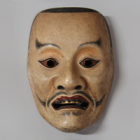Japanese Gallery (Honkan) Room 14
August 25, 2020 (Tue) - October 4, 2020 (Sun)
During the Azuchi-Momoyama period (1573–1603), an increasing number of samurai lords came to appreciate the medieval noh theater. This dramatic rise of noh devotees caused a surge in demand for copies of old masks, which led to the emergence of mask-carving families who inherited and passed on methods of creating noh masks. In this exhibition, we are introducing masks made by artisans of two of these families: the Echizendeme and the Ōnodeme.
The founder of the Echizendeme, Mitsuteru, was active in the late Muromachi period (1392–1573), and the first-generation carver of the Ōnodeme, Zekan, was active from the Azuchi-Momoyama period. We invite our visitors to learn more about the histories of these famous families of carvers while looking at their works.

